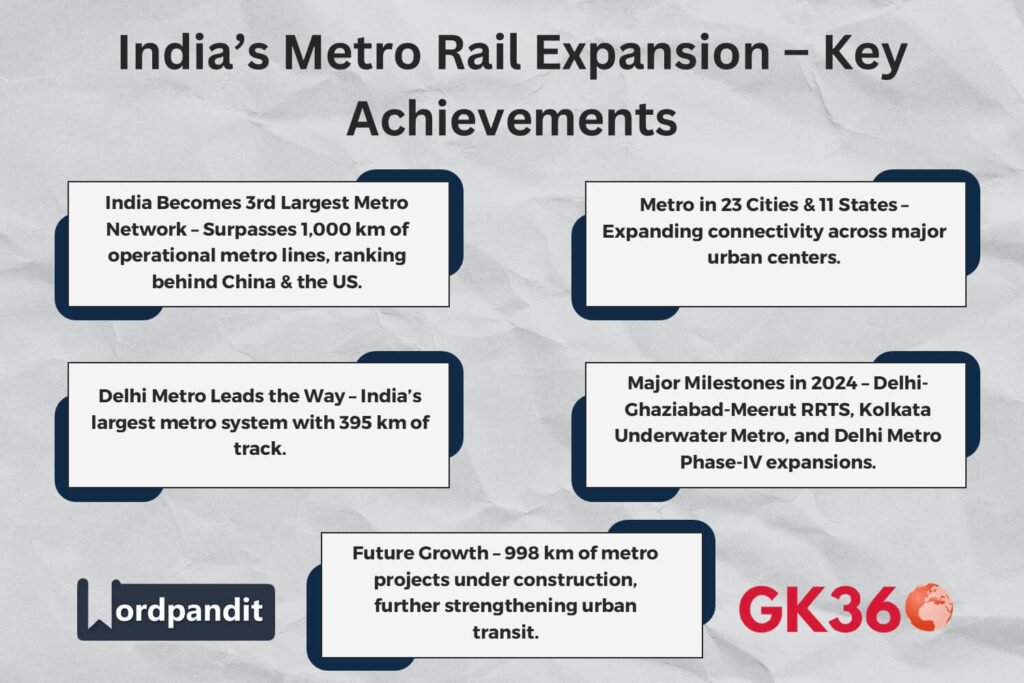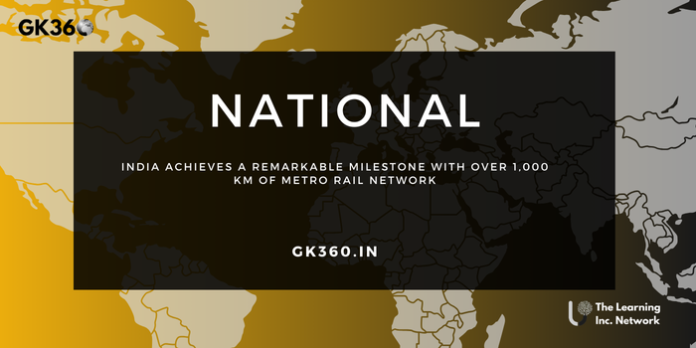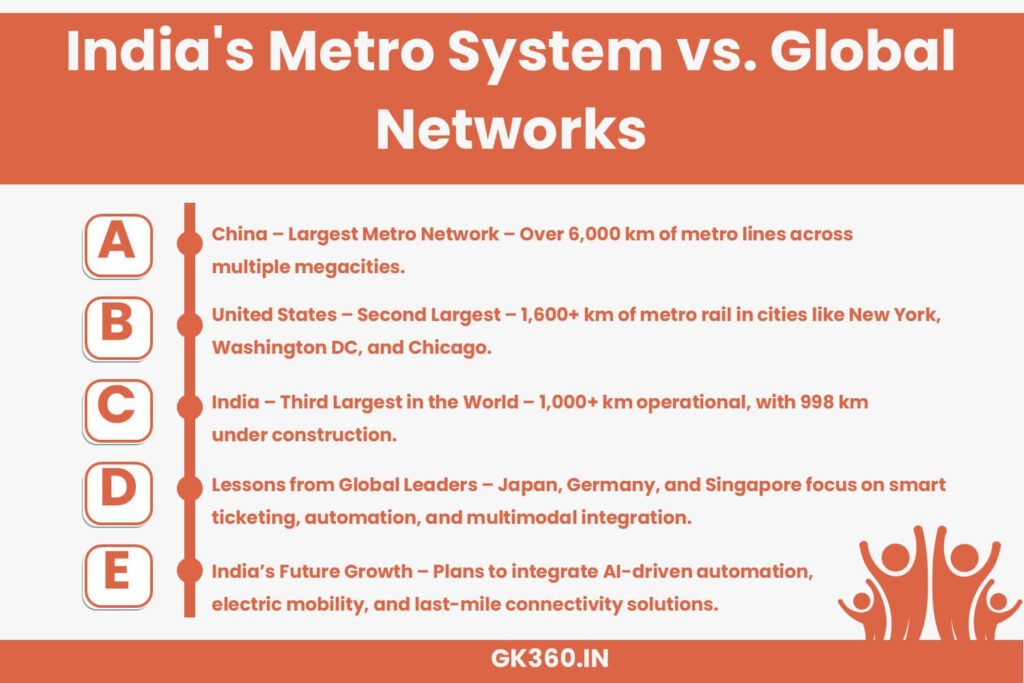India’s Metro Network Surpasses 1,000 km: The Third Largest in the World
Introduction
India has reached a remarkable milestone by surpassing 1,000 kilometers of operational metro rail network, securing its place as the third-largest metro system globally. This achievement places India behind only China and the United States in terms of metro rail infrastructure, marking a significant step forward in the nation’s urban transportation development. With continuous expansion and modernization, India’s metro rail network is revolutionizing urban mobility, reducing traffic congestion, and promoting sustainable transportation.

Table of Contents
- India’s Metro Network: A Historic Achievement
- How India Became the 3rd Largest Metro Network
- Key Milestones in India’s Metro Expansion (2024)
- Metro Rail Network in 2025: Expansion Plans & Future Growth
- India vs The World: How It Compares Globally
- FAQs: India’s Metro Rail Growth
- Conclusion: India’s Urban Transport Revolution
India’s Metro Network: A Historic Achievement
India’s metro rail system has undergone significant transformation over the past four decades. From the Kolkata Metro’s humble beginnings in 1984 to the highly advanced networks spanning multiple cities today, India has consistently expanded its public transit solutions to meet the needs of its growing urban population.
How India Became the 3rd Largest Metro Network
India’s metro system’s rapid growth began with the introduction of the Kolkata Metro in 1984. Since then, the system has steadily expanded to become the third-largest metro network in the world, after China and the United States. This growth can be attributed to strategic planning, investment in infrastructure, and the increasing demand for sustainable urban mobility solutions.
Kolkata Metro: India’s First Urban Rail System (1984)
The Kolkata Metro was India’s first step into mass rapid transit, introducing modern urban mobility in 1984. As a pioneer in the Indian metro sector, it paved the way for future expansions across the country.
Delhi Metro: Revolutionizing Urban Transit (2002)
The Delhi Metro, launched in 2002, introduced cutting-edge infrastructure, energy-efficient systems, and advanced automation. It has since grown into India’s largest metro system, with a total operational reach of 395 kilometers.
Key Milestones in India’s Metro Expansion (2024)
India’s metro network has reached new heights in 2024, with several key expansions and projects set to further transform urban transit. These milestones highlight the country’s growing commitment to improving mobility and reducing congestion in its cities.
Delhi Metro Phase-IV: New Connectivity Boost
- Inaugurated in January 2024, the latest expansion added 2.8 kilometers between Janakpuri and Krishna Park.
- This initiative is part of the Delhi Metro Phase-IV plan, designed to enhance connectivity and improve commuter convenience.
Delhi-Ghaziabad-Meerut RRTS: India’s High-Speed Transit
- The Delhi-Ghaziabad-Meerut RRTS, also called the Namo Bharat corridor, became operational in early 2024.
- The first 13-kilometer segment offers a high-speed transit option, reducing travel time significantly between Delhi and its neighboring cities.
Kolkata’s Underwater Metro: An Engineering Marvel
- In March 2024, India witnessed the launch of its first underwater metro line in Kolkata.
- A 520-meter tunnel beneath the Hooghly River allows trains to cross in just 45 seconds.
- This feat showcases India’s engineering expertise and commitment to urban infrastructure innovation.
Metro Rail Network in 2025: Expansion Plans & Future Growth
India’s metro network is set to expand further in the coming years, with several major projects under construction and cities increasingly relying on metro systems for efficient urban mobility. The future of metro rail in India looks promising, with a focus on enhancing connectivity and integration with other forms of transportation.
Cities with Metro Services
As of January 2025, metro services operate across 11 Indian states and 23 cities, demonstrating India’s commitment to efficient public transport solutions. Major urban centers like Delhi, Mumbai, Bengaluru, Chennai, and Kolkata are benefiting from rapid metro expansion, while smaller cities are also beginning to integrate metro systems into their transport infrastructure.
Ongoing Metro Rail Projects
- More than 998 kilometers of metro rail projects are currently under construction.
- Future expansions aim to enhance urban connectivity and cater to India’s rapidly growing population.
India vs The World: How It Compares Globally
India’s metro system has made significant strides in recent years, securing its place as the third-largest metro network in the world. This section compares India’s metro expansion with global leaders and discusses valuable lessons from their experiences.
Metro Rail Leaders: China, US, and India
- China: World’s largest metro network, exceeding 6,000 km.
- United States: Over 1,600 km of metro rail systems across multiple cities.
- India: Now third globally, with 1,000+ km of operational metro rail.
Lessons from Global Metro Expansion
- Sustainable urban planning: Countries like Japan and Germany have integrated eco-friendly metro solutions.
- Smart ticketing & automation: Cities like London and Singapore leverage AI-driven metro ticketing systems.
- Multimodal integration: Leading metros seamlessly connect with bus and rail networks.
FAQs: India’s Metro Rail Growth
Here are some frequently asked questions about India’s metro rail system and its future development:
- Why is India’s metro expansion significant? India’s rapid metro expansion reduces traffic congestion, pollution, and enhances urban connectivity.
- How many Indian cities have metro services? Currently, 23 cities across 11 states have operational metro rail services.
- What are the biggest metro rail projects underway? Major projects include Bangalore Metro Phase-III, Chennai Metro Phase-II, and Mumbai Metro Line-7.
- How does India’s metro compare to global networks? India’s metro system ranks third globally after China and the US.
- What is the future of metro rail in India? With 998 km of ongoing construction, metro rail will expand to more cities, improve last-mile connectivity, and integrate with high-speed rail.
Conclusion: India’s Urban Transport Revolution
India’s metro rail expansion signifies a massive leap in urban transportation. From the humble beginnings of the Kolkata Metro to cutting-edge developments like the Kolkata Underwater Metro, India continues to innovate in public transit infrastructure. With an additional 998 kilometers of metro projects in the pipeline, India is set to further solidify its position as a global leader in urban mobility.
Key Takeaways Table
| Aspect | Details |
|---|---|
| Total Metro Network | 1,000+ km operational, making India third-largest globally |
| Largest Metro System in India | Delhi Metro – 395 km of track |
| Major 2024 Expansions | Delhi Metro Phase-IV, Delhi-Ghaziabad-Meerut RRTS, Kolkata Underwater Metro |
| Number of Metro Cities | 23 cities across 11 states have metro services |
| Ongoing Projects | 998 km of metro under construction, set to expand connectivity further |
| Global Rank | China (6,000+ km) > US (1,600+ km) > India (1,000+ km) |
| Future Vision | AI-driven automation, smart ticketing, and seamless multimodal integration |
Related Terms:
- India Metro Network 2024
- Largest Metro Systems in the World
- India Metro Expansion Plans
- Delhi Metro Phase-IV Updates
- Kolkata Underwater Metro 2024
- Namo Bharat RRTS Corridor
- Urban Mobility in India
- Public Transport Growth India
- Metro Connectivity Expansion in India
- Future of Metro Rail in India






